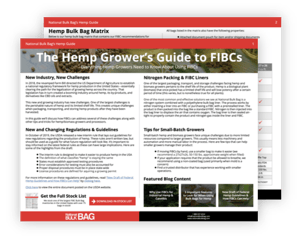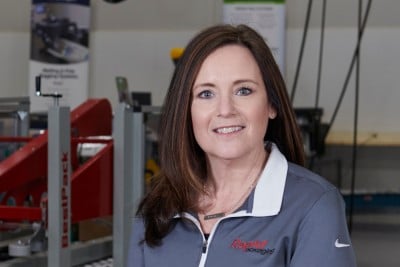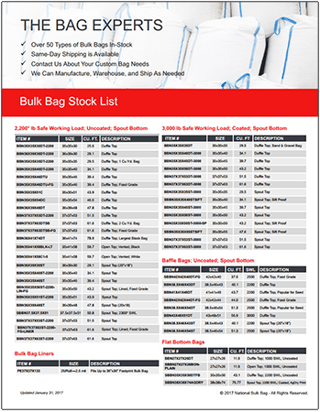Companies and users are constantly finding new ways to use bulk bags as the FIBC industry continues to develop and expand into new markets and industries. At National Bulk Bag, we are continually amazed at the conversations we have with current and prospective customers about their innovative product and/or application uses. It’s a testament to not only the ingenuity of end-users but also the flexible and versatile nature of woven polypropylene bags.
This also means that there is constant demand for suppliers and distributors to continue to innovate regarding the solutions they provide. For example, the hemp industry in the United States is a booming new sector of the American economy – and a newer industry user of bulk bags. This new industry has unique challenges that require unique solutions. One of these challenges is something called bridging. What is bridging? How does it impact using bulk bags with hemp/biomass? What can you do to minimize it? Let’s explore.
What is FIBC Bridging?
One of the most common types of construction in the bulk bag industry is spout bottom bags. However, because of the way these bags are commonly manufactured, the spout bottom and the limited circumference of the discharge spout can create issues when discharging specific products like hemp/biomass.
FIBC bridging occurs when the product/biomass “bridges” by sticking to itself during discharge. This results in the clogging of the spout and halts the discharge of product from the bag. This is a big problem for many hemp/biomass growers and significantly increases the time it takes to discharge a bag. Mitigating this issue can also be a significant safety hazard as workers are sometimes required to unclog the spout by getting near the bag during discharge. This is an unacceptable situation for many companies – but what can you do to properly mitigate this?
What Can You Do About FIBC Bridging?
There are a few different ways users are combating bridging – however, not all are equally safe. The most common method we see a lot of our customers using is bag cutting. This is done instead of using the discharge spout. A user simply cuts the entire bottom of the bag out end to end and allows the product to discharge uncontrolled. On top of ultimately destroying the bag, this also presents several safety issues. First, it involves the handling of sharp objects during discharge. Second, it involves an individual standing underneath the bag while uneven discharge occurs. There is also an additional risk of contamination as cut strands of woven polypropylene can become dislodged from the bag and end up in your product.
The issues noted above lead us to recommend several different approaches. Our first and highest recommendation is an oversized discharge spout. It works essentially the exact same way as a standard discharge spout except due to the larger circumference of the spout, the risk of bridging is significantly less. The wider opening at the bottom of the bag allows even the most moisture rich products to successfully exit the bag during discharge. Compared to bag cutting, this results in no bag destruction and overall a much safer discharge process. As always, ask your distributor if they have this solution available.
Another solution is full-bottom discharge (often referred to as “diaper-bottom discharge” bags). Often available through a custom-solution from your distributor, full-bottom discharge bags are exactly as they sound. In full-bottom discharge bags, the entire bottom of the bag is essentially a discharge spout. Think of it like a duffle-top solution, except on the bottom of your bag. For more information on full-bottom discharge, check out our post by clicking here.
Everything You Need to Know about Using FIBCs with Hemp.
 The booming hemp industry is creating unique challenges for growers and processors alike. With the lack of reliable education on the internet, the hemp industry is commonly asking questions like how do I properly store my hemp and biomass? How can I extend my product’s shelf-life? How can I reduce the risk of mold and contamination? Is there an easier way to empty my bulk bags?
The booming hemp industry is creating unique challenges for growers and processors alike. With the lack of reliable education on the internet, the hemp industry is commonly asking questions like how do I properly store my hemp and biomass? How can I extend my product’s shelf-life? How can I reduce the risk of mold and contamination? Is there an easier way to empty my bulk bags?
In our new Hemp Grower's Guide to FIBCS, we discuss how FIBCs can help address the various challenges hemp growers face.






